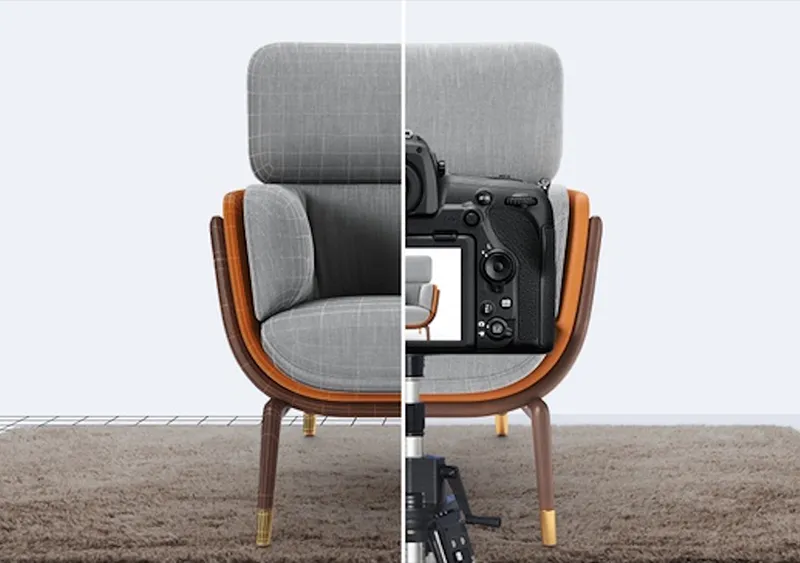How 3D Models Help Furniture Brands Improve Customer Experience
How 3D Models Revolutionize the Furniture Shopping Experience

5 MIN READ
April 3, 2025

Written By
Allwyn Ruban
That’s where 3D product modeling service steps in. It allows furniture brands to showcase their products from every angle, in high resolution, with customizable features that mimic an in-store experience—without the customer ever stepping foot inside a showroom.
From interactive views to AR placement tools, 3D models are transforming how customers engage with furniture online. They’re not just seeing the product—they’re experiencing it.
Now, let’s explore how forward-thinking furniture brands are using 3D modeling to boost customer confidence, reduce friction, and deliver a shopping experience that feels personal and precise.
How Interactive Visuals Enhance Every Stage of the Furniture Buyer’s Journey
Today’s furniture buyers don't just want to see a product. They want to interact with it. Here's how interactive visuals elevate every step of the customer journey.
1. Let Them See It All: 360° Product Views
Think about how people shop in a store—they walk around a chair, feel the texture, examine the stitching, and peek underneath. Online shopping strips away that experience unless brands find a way to recreate it digitally. That’s where 360-degree views come in.
With interactive 3D models, buyers can rotate the product, zoom in on small details, and explore it from any perspective. This gives them a sense of ownership before they even click "Buy Now." It reduces uncertainty and replaces passive scrolling with active decision-making.
When customers feel like they’ve “handled” the product virtually, they’re far more confident about the purchase.
2. Real-Time Personalization Makes It Theirs
Furniture is a personal choice. No two homes are the same, so no shopper wants a one-size-fits-all product image. Real-time 3D customization tools empower customers to make the product their own, visually and emotionally.
Imagine choosing a sofa, then instantly switching between 10 fabrics, 5 wood finishes, or 3 armrest styles. Within seconds, the customer sees their version of the product, not just a stock image.
This layer of personalization increases emotional attachment, shortens decision cycles, and often leads to larger cart values as shoppers invest in options they’ve hand-picked. For businesses looking to implement this level of customization, outsourcing 3D architectural visualization can be a highly efficient and scalable solution.
3. Visualize It at Home with AR
What if you could bring the showroom into your living room?
Augmented Reality (AR) does exactly that. By combining 3D models with AR technology, furniture brands allow customers to place a digital version of the product right in their space.
The value here isn’t just visual—it’s spatial. Customers can check scale, see how light affects the finish, and compare styles with existing decor. It removes the two biggest online shopping fears: “Will it fit?” and “Will it look right?”
AR-driven confidence is powerful. It not only improves purchase decisions but builds lasting trust with the brand offering that capability.
4. More Confident Decisions Mean Fewer Returns
Returns cost time, money, and customer satisfaction. Many happen not because the product was defective, but because it didn't meet expectations. That gap between expectation and reality? 3D rendering closes it.
With interactive previews, buyers see the exact shade of walnut, understand the texture of the fabric, and visualize proportions in context. These aren’t guesses—they’re informed, confident decisions.
When customers are better informed, they rarely send things back. That means fewer return-related losses for your brand and a smoother post-purchase experience for the buyer.
5. Turning Browsers Into Buyers
Engagement is the invisible force behind conversions. The longer a customer spends with your product, the more likely they are to buy. 3D visuals turn casual browsing into active participation.
When shoppers can tweak, rotate, and explore products in real-time, they stop passively scrolling. They start interacting. They begin imagining.
And that shift, from looking to envisioning—is when buying decisions are made.
What starts as a curious click becomes a confident choice. And in a digital world full of distractions, interaction is the clearest path to action.
How Top Brands Use 3D Modeling
Brands like IKEA and Wayfair have leaned into 3D visualization and AR not because it’s flashy, but because it works. Both companies have leveraged advanced 3D furniture modeling services to create realistic, interactive product experiences that drive results.
- IKEA’s Place app lets users position furniture in their homes using AR. It’s not just cool—it has helped reduce returns and increase mobile conversions.
- Wayfair’s 3D Room Planner allows for full layout planning, giving customers total control over how products fit into their space.
These aren’t experimental tools, they’re core to how these brands serve and sell. The takeaway? Customers expect interactivity. Brands that provide it are the ones that lead.
Conclusion
Furniture Shopping Is Evolving.
So Should Your Brand!
The way people buy furniture has changed. Customers no longer settle for vague product images and guesswork. They expect to interact, customize, and visualize. When brands deliver that experience, they don't just make a sale. They build trust.
What once required a physical showroom now happens through a screen. But only if the digital experience feels just as real. This is where intelligent 3D visuals come in. Not flashy. Not complicated. Just clear, immersive, and accurate.
At ZealousXR, we create more than 3D models. We help furniture brands turn their online presence into a space where buyers feel confident and connected.
About the writer :
Allwyn Ruban heads business development and marketing at Zealous Services. He’s the go-to person for finding smart ... ways to grow their 3D services, from animation to modeling. With a knack for digital strategy, Allwyn is all about helping clients achieve their goals while expanding Zealous' reach in the industry. His friendly approach makes collaboration easy and effective.
Read MoreFrequently Asked Questions (FAQ)
1. How do 3D models improve online furniture shopping?
3D models give customers a complete, interactive view of a product. Instead of relying on static images, shoppers can rotate, zoom in, and explore every detail, helping them make confident purchase decisions without visiting a showroom.
2. Can customers customize furniture using 3D models?
Yes. Many 3D product viewers allow real-time customization. Shoppers can change colors, materials, sizes, or configurations and instantly see how their chosen options look, creating a more personal and engaging experience.
3. How does AR integration enhance the furniture buying process?
Augmented reality lets customers place 3D furniture models in their actual space using their smartphone or tablet. It helps them check fit, match styles, and reduce uncertainty before buying.
4. Do 3D models help reduce product returns?
They do. By offering a clear and realistic preview of the product, 3D models set accurate expectations. Customers know what they’re getting, which significantly lowers the chance of disappointment and returns.
5. How can ZealousXR support furniture brands with 3D modeling?
ZealousXR creates high-quality, interactive 3D models that are optimized for e-commerce. We help furniture brands upgrade their customer experience with tools like real-time customization, AR-ready models, and immersive product visualization